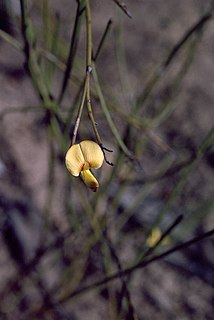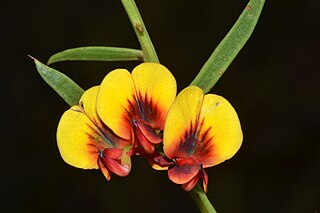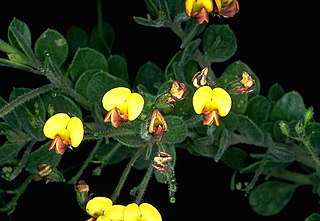
Daviesia obovata, commonly known as paddle-leaf daviesia, is a species of flowering plant in the family Fabaceae and is endemic to the south-west of Western Australia. It is an erect, slender shrub with scattered egg-shaped phyllodes with the narrower end towards the base, and yellow flowers with pale green markings.

Daviesia abnormis is a species of flowering plant in the family Fabaceae and is endemic to the south-west of Western Australia. It is an erect, hairy shrub with sharply-pointed, narrow elliptic to narrow egg-shaped phyllodes with the narrower end towards the base, and yellow flowers with faint red markings.

Daviesia anceps is a species of flowering plant in the family Fabaceae and is endemic to the south of Western Australia. It is a dense, erect or low-lying shrub with its branchlets reduced to flattened cladodes, and yellow flowers with red markings.

Daviesia angulata is a species of flowering plant in the family Fabaceae and is endemic to the south-west of Western Australia. It is an erect, spreading shrub with prickly, flattened phyllodes, and yellow flowers with red markings.

Daviesia crassa is a species of flowering plant in the family Fabaceae and is endemic to the south-west of Western Australia. It is a compact, dense, glabrous shrub with densely crowded, thick, club-shaped phyllodes, and uniformly yellow flowers.

Daviesia crenulata is a species of flowering plant in the family Fabaceae and is endemic to the south-west of Western Australia. It is a bushy shrub with broadly egg-shaped phyllodes with a sharply-pointed end and wavy edges, and uniformly yellow-orange and maroon flowers.

Daviesia daphnoides is a species of flowering plant in the family Fabaceae and is endemic to the south-west of Western Australia. It is a bushy or spreading shrub with glabrous foliage, sharply-pointed narrow elliptic to egg-shaped phyllodes with the narrower end towards the base and yellow and dark red flowers.

Daviesia aphylla is a species of flowering plant in the family Fabaceae and is endemic to the south-west of Western Australia. It is an erect, bushy shrub with glabrous foliage, up to six sharply-pointed phyllodes on each branchlet, and orange-red and yellow flowers.

Daviesia lancifolia is a species of flowering plant in the family Fabaceae and is endemic to the south-west of Western Australia. It is a prostrate to erect, spreading shrub with egg-shaped, more or less round or linear phyllodes and yellow to orange and red flowers.

Daviesia mesophylla is a species of flowering plant in the family Fabaceae and is endemic to the south-west of Western Australia. It is a low-lying, glabrous shrub with sharply-pointed, linear or narrowly egg-shaped phyllodes with the narrower end towards the base, and yellow to orange, red and cream-coloured flowers.

Daviesia mollis is a species of flowering plant in the family Fabaceae and is endemic to the south-west of Western Australia. It is a small shrub with softly-hairy foliage, scattered elliptic phyllodes, and yellow and reddish flowers.

Daviesia oxyclada is a species of flowering plant in the family Fabaceae and is endemic to the south-west of Western Australia. It is a densely-branched, glabrous shrub with spiny stems, vertically compressed, triangular phyllodes with the narrower end towards the base, and yellow or orange flowers with red markings.
Daviesia pachyloma is a species of flowering plant in the family Fabaceae and is endemic to the south-west of Western Australia. It is an erect, bushy or spreading shrub with zigzagging branches, sharply-pointed, narrowly elliptic to linear phyllodes, and yellow and red flowers.
Daviesia pectinata, commonly known as thorny bitter-pea, is a species of flowering plant in the family Fabaceae and is endemic to south-eastern continental Australia. It is a dense, rigid shrub with erect, flattened branchlets, crowded, flattened, triangular phyllodes, and yellow to orange and reddish flowers.
Daviesia podophylla, commonly known as buggery bush, is a species of flowering plant in the family Fabaceae and is endemic to the south-west of Western Australia. It is an openly-branched, glabrous, glaucous shrub with many often sharply-pointed branchlets, triangular phyllodes with a sharp point on the end, and orange-yellow, dark red and black flowers.

Daviesia quadrilatera, commonly known as buggery bush, is a species of flowering plant in the family Fabaceae and is endemic to the south-west of Western Australia. It is a robust, erect, glabrous shrub with angular branchlets, vertically flattened, sharply-pointed quadrilateral or triangular phyllodes with a sharp point on the end, and yellow to orange and red flowers.

Daviesia retrorsa is a species of flowering plant in the family Fabaceae and is endemic to the south of Western Australia. It is a dense, tangled shrub with glabrous branchlets and leaves, scattered, needle-like, sharply pointed phyllodes turned backwards, and orange-yellow and red flowers.
Daviesia scoparia is a species of flowering plant in the family Fabaceae and is endemic to the south-west of Western Australia. It is a broom-like, glabrous, leafless shrub with yellow, dark reddish-brown and maroon flowers.

Daviesia spinosissima is a species of flowering plant in the family Fabaceae and is endemic to the south of Western Australia. It is a shrub with crowded, rigid, sharply-pointed, narrowly triangular phyllodes, and yellow and red flowers.
Daviesia stricta is a species of flowering plant in the family Fabaceae and is endemic to inland areas of South Australia. It is an open, glabrous shrub with narrowly-winged branchlets, scattered, narrowly elliptic to linear phyllodes and orange and purplish flowers.















